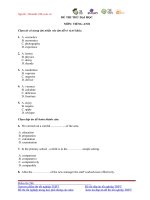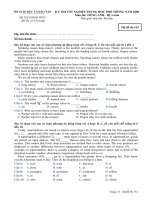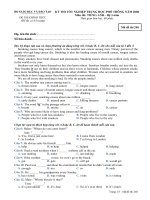Outline môn Tiếng Anh - Company Structure
Bạn đang xem bản rút gọn của tài liệu. Xem và tải ngay bản đầy đủ của tài liệu tại đây (581.58 KB, 33 trang )
Company Structure
Group 5
Members
1. Nghiêm Lê Phúc Hà - 1102015009
2. Trịnh Văn Nhất - 1102015043
3. Trương Quang Tuấn - 1102015083
4. Từ Anh Khoa - 1102015031
5. Nguyễn Ngọc Nguyệt Thuý - 1102015068
6. Nguyễn Thị Thuỳ Trang - 1102015077
7. Bùi Văn Đông - 1102015006
8. Trần Thị Ngọc Châu - 0902021003
Content
I. Definition
II. Classification (Types of Company)
III. Company structure
IV. Advantages and Disadvantages
V. Translation
VI. Exercises
Definition
What is a company structure?
The typically hierarchical arrangement of lines
of authority, communications, rights and duties
of an organization.
Company structure determines how the roles,
power and responsibilities are assigned,
controlled, and coordinated, and how
information flows between the different levels of
management.
Types of Company
Joint Stock Company (Enterprise)
Private Enterprise
Limited Company
State Company
Foreign Company
Joint Venture Company
Company Structure
Line structure
Functional structure
Staff position
Matrix structure
Product structure
Line structure
•
A line structure is a hierarchical system that denotes the
rank of staff from the top manager to the person at the
bottom. In the hierarchy, each person at the top has
authority over his subordinates or the people below him
or her.
CEO
Production
Manager
Marketing
Manager
Sale
Manager
Staff Staff
Advantages & Disadvantages
•
Simple
•
Prompt decisions
•
Unity of command
•
Better discipline
•
Flexible
•
Accountable for
results
•
Economical
•
Lack of specialization
•
Overburdened
•
Autocratic control
•
Instability.
Advantages Disadvantages
Functional structure
•
A functional organisational structure is a structure that
consists of activities such as coordination, supervision
and task allocation. The organisational structure
determines how the organisation performs or operates.
CEO
Production
Manager
Marketing
Manager
Sale
Manager
Staff Staff
Advantages & Disadvantages
•
Learn a lot from
each other
•
Problem solving
easier
•
Find more skilled
employees
•
Increasing in control
•
Effected team work
•
Become short-
sighted rather than
proactive
•
Lack of
communication
•
Difficult to analyze
which person is more
efficient and which is
not.
Advantages Disadvantages
Staff position
•
Job position within a chain of command of
an organization that has
the responsibility of providing information and advice to p
ersonnel in the line position.
CEO
Production
Manager
Marketing
Manager
Sale
Manager
Staff Staff
Assistant
Advantages & Disadvantages
•
Staff personnel use their
technical expertise to
assist line personnel.
•
aid top management in
various business activities.
•
provide support, advice,
and knowledge to other
individuals in the chain of
command.
•
No need for all round
executives.
•
conflict between line and
staff personnel.
•
Staff people may resent
their lack of authority
•
Co-ordination between line
and staff may become
difficult.
Advantages Disadvantages
Matrix structure
•
A matrix organization structure is usually defined as one
where there are multiple reporting lines – that is, people
have more than one formal boss.
CEO
Production
Manager
Marketing
Manager
Sale
Manager
Staff Staff Staff Staff
Advantages & Disadvantages
•
Minimization of project
costs, due to sharing of
resources.
•
Minimization of conflicts
•
Balance between time,
cost and performance
•
Sharing of authority and
responsibility
•
Stress distribution
between the team
•
Information sharing
•
Not suitable for small
organizations
•
Complete responsibility of
the Manager for success or
failure
•
The team lead gets all the
credit
•
Suitable only for project
based organization.
Advantages Disadvantages
What structure should you
choose for your company?
How big is your company?
What does your company
produce?
How many departments
does your company have?
Vocabulary
1. Autonomous
2. Decentralization
3. Function
4. Hierarchy
5. line authority
6. report to
7. subordinates
A. a system of authority with
different levels, one above the
other
B. a specific activity in a company,
e.g production, marketing,
finance
C. independent, able to take
decisions without consulting a
higher authority
D. people working under someone
else in a hierarchy
E. dividing an organization into
decision-making units that are not
centrally controlled
F. the power to give instructions to
people at the level below in the
chain of command
G. to be responsible instructions
from him or her
Most organizations have a
hierarchical or pyramidal
structure, with one person or a
group of people below them at
each successive level. There is a
clear line or chain of command
running down the pyramid. All
the people in the organization
know what decisions they are
able to make, who their superior
(or boss) is (to whom they
report), and who their immediate
subordinates are (to whom they
can give instructions).
Hầu hết các doanh nghiệp, tổ chức
được cấu trúc phân cấp hay kim tự
tháp, với một người hoặc một
nhóm người đứng đầu và ở mỗi
cấp kế tiếp dưới họ số lượng nhân
viên càng tăng. Các lệnh được đưa
xuống trực tiếp hoặc theo chuỗi
xuyên suốt kim tự tháp. Tất cả mọi
người trong tổ chức biết được
những quyết định nào họ có thể
đưa ra, những ai là cấp trên (hoặc
ông chủ mà họ phải báo cáo), và
những ai là cấp dưới trực tiếp (mà
họ dẫn dắt).
Some people in an organization
have colleagues who help them:
for example, there might be an
Assistant Marketing Manager.
This is known as a staff position:
its holder has no line authority,
and is not integrated into the
chain of command, unlike, for
example, the Assistant
Marketing Manager, who is
number two in the marketing
department.
Một số người trong một tổ chức có
những người đồng nghiệp giúp họ:
ví dụ, có thể có một Trợ lý trưởng
phòng tiếp thị. Người này được
biết đến như một nhân viên bình
thường: không có thẩm quyền và
không được tham gia vào các hệ
thống quản lý, khác biệt với Phó
phòng Tiếp thị, là người thứ hai
trong bộ phận tiếp thị.
Yet the activities of the most
companies are too complicated to
be organized in a single hierarchy.
Shortly before the First World War,
the French industrialist Henry Fayol
organized his coal mining business
according to functions that it had to
carry out. He is generally credited
with inventing functional
organization. Today, most large
manufacturing organizations have a
functional structure, including
(among others) production, finance,
marketing, sales, and personnel or
human resources departments. This
means, for example, that the
production and marketing
departments cannot take financial
decisions without consulting the
finance department.
Tuy nhiên, các hoạt động của hầu hết
các công ty rất phức tạp để tổ chức
theo một hệ thống phân cấp duy nhất.
Ngay trước chiến tranh thế giới thứ
nhất, nhà công nghiệp Pháp Henry
Fayol tổ chức kinh doanh khai thác
than của mình theo chức năng mà nó
phải thực hiện. Ông thường được coi
là người phát minh ra cấu trúc doanh
nghiệp theo chức năng. Hiện nay, hầu
hết các tổ chức sản xuất lớn có một
cấu trúc chức năng, bao gồm (trong
số các phòng ban) các phòng ban sản
xuất, tài chính, tiếp thị, bán hàng,
nhân viên hoặc nhân sự. Ví dụ như,
bộ phận sản xuất và tiếp thị chỉ có thể
đưa ra quyết định tài chính khi có ý
kiến của bộ phận tài chính.
Functional organization is
efficient, but there are two
standard criticisms. Firstly, are
usually more concerned with the
success of their department than
that of the company, so there are
permanent battles between, for
example, finance and marketing,
or marketing and production,
which have incompatible goals.
Secondly, separating functions is
unlikely to encourage
innovation.
Tổ chức theo chức năng khá hiệu
quả, nhưng có hai nhược điểm cơ
bản. Thứ nhất, mỗi bộ phận
thường quan tâm nhiều đến sự
thành công của họ hơn là sự thành
công của cả công ty, do đó luôn có
những đấu tranh nội bộ, ví dụ giữa
bộ phận tài chính và tiếp thị, hoặc
tiếp thị và sản xuất, vì họ không có
mục tiêu tương đồng. Thứ hai,
phân chia chức năng khó có thể
khuyến khích sự đổi mới.
Yet for a large organization
manufacturing a range of
products, having a single
production department is
generally inefficient.
Consequently, most large
companies are decentralized,
following the model of Alfred
Sloan, who divided General
Motors into separate operating
divisions in 1920. Each divisions
had its own engineering,
production and sales department,
made a different category of car
(but with some overlap, to
encourage internal competition),
and was expected to make a
profit.
Tuy nhiên đối với một tổ chức lớn
sản xuất một loạt các sản phẩm, có
một bộ phận sản xuất duy nhất
thường không hiệu quả. Do đó,
hầu hết các công ty lớn được phân
cấp theo mô hình của Alfred
Sloan, người chia General Motors
thành những nhóm hoạt động riêng
biệt trong năm 1920. Mỗi nhóm có
kỹ thuật viên, bộ phận sản xuất và
bán hàng riêng của mình, thực
hiện mỗi phần khác nhau của xe
(nhưng có một số chồng chéo lên
nhau, khuyến khích cạnh tranh nội
bộ), và dự kiến sẽ tạo ra lợi nhuận.
Business that cannot be divided
into autonomous divisions with
their own markets can simulate
decentralization, setting up
divisions that deal with each
other using internally
determined transfer prices. Many
banks, for example, have
established commercial,
corporate, private banking,
international and investment
divisions.
Việc kinh doanh không thể chia
thành các đơn vị độc lập theo từng
thị trường của họ nhưng có thể mô
phỏng phân cấp, thiết lập các bộ
phận thương lượng nội bộ với
nhau bằng cách sử dụng giá
chuyển nhượng xác định. Ví dụ:
nhiều ngân hàng đã thiết lập các
đơn vị thương mại, doanh nghiệp,
ngân hàng tư nhân, quốc tế và các
đơn vị đầu tư.
An inherent problem of hierarchies
is that people at lower levels are
unable to make important decisions,
but have to pass on responsibility to
their boss. One solution to this is
matrix management, in which
people report to more than one
superior. For example, a product
manager with an idea might be able
to deal directly, with managers
responsible for a certain market
segment and for a geographical
region, as well as the managers
responsible for the traditional
functional of finance, sales and
production.
Một nhược điểm mang tính thừa
hưởng của hệ thống phân cấp là
những người ở cấp thấp hơn không
thể đưa ra quyết định quan trọng,
nhưng phải chuyển trách nhiệm đó lên
cấp trên của họ. Một giải pháp cho
vấn đề này là quản lý theo ma trận,
theo đó một người có thể báo cáo cho
nhiều cấp trên khác nhau. Ví dụ, một
nhà quản lý sản phẩm có thể đưa ra ý
tưởng công việc với những giám đốc
chịu trách nhiệm cho phân khúc thị
trường của sản phẩm đó ở vùng địa lý
mà họ quản lý, cũng như báo cáo ý
tưởng đó với những giám đốc ở các
chức năng khác như trưởng phòng tài
chính, trưởng phòng kinh doanh hoặc
trưởng phòng sản xuất.
This is one way of keeping
authority at lower levels, but it is
not necessary a very efficient
one. Thomas Peters and Robert
Waterman, in their well-known
book In Search of Excellent,
insist on the necessity of pushing
authority and autonomy down
the line, but they argue that one
element probably the product –
must have priority; four-
dimensional matrices are far too
complex.
Đây là một giải pháp để giữ quyền
phát biểu ở các cấp thấp hơn
nhưng lại không phải là giải pháp
hiệu quả nhất. Thomas Peters và
Robert Waterman đã chỉ ra trong
cuốn sách “ Tìm kiếm sự ưu tú”
của họ, nhấn mạnh vào sự cần thiết
phải thúc đẩy quyền tự chủ ở các
cấp dưới hơn, nhưng họ cũng lập
luận rằng đối với yếu tố quan
trọng - yếu tố sản phẩm - yếu tố
luôn phải đặt lên hàng đầu thì quản
lý theo ma trận 4 chiều là quá
phức tạp.
A further possibility is to have
wholly autonomous temporary
groups or team that are
responsible for an entire project,
and are split up as soon as it is
successfully completed. Teams
are often not very good for
decision-making, and they run
the risk of relational problems,
unless they are small and have a
lot of self-discipline. In fact they
still require a definite leader, on
whom their success probably
depends.
Một khả năng nữa để có sự tự chủ
hoàn toàn là những nhóm tạm thời
chịu trách nhiệm cho toàn bộ dự
án sẽ bị giải thể ngay sau khi dự án
đó được hoàn thành. Những nhóm
này thường không có ảnh hưởng
tốt trong việc ra quyết định và có
nguy cơ làm phát sinh các vấn đề
liên quan trừ khi các nhóm này
nhỏ và có tính kỷ luật cao.Trong
thực tế, những nhóm này cần 1
người lãnh đạo rõ ràng, người lãnh
đạo này sẽ quyết định sự thành
công của họ.









